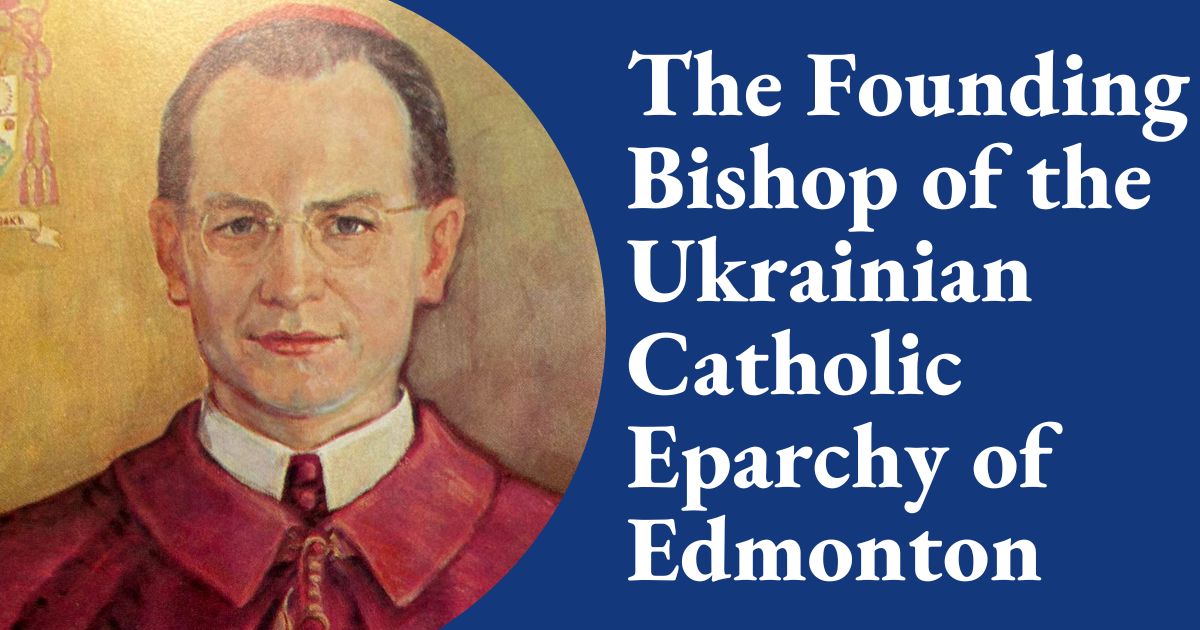Article Written By: Rev. Dr Athanasius D. McVay
Read this article in Ukrainian: https://synod.ugcc.ua/data/vladyka-nil-savaryn-3396/
Bishop Nil was the founding bishop of the Ukrainian Catholic Eparchy of Edmonton. Born Mykola Savaryn in Staryi Sambir on 19 May 1905. He attended school locally and, at age 17, entered the Basilian Order on 22 August 1922 taking the monastic name “Nil” (Neil). He studied humanities, philosophy, and theology at the Basilians’ study houses of Lavriv, Dobromyl, and Krystynopil. On 14 September 1930, he made his Solemn profession in the Order and was ordained to the priesthood by Blessed Yosafat Kotsylovsky on 23 August 1931. The following summer, he enlisted for missionary work in North America and departed for Canada in September 1932.
Father Nil was assigned to the Basilian motherhouse in Mundare, Alberta, where he taught humanities and philosophy to new recruits. He also performed pastoral work in the mission stations entrusted to the monastery. His humble demeanour, piety, and zeal earned him the respect of his confreres and the affection of the faithful. Within the monastery he served as assistant master of novices, bursar, and superior from 1938.
Bishop Vasyliy Ladyka’s requests for an auxiliary bishop remained unanswered for over ten years. Finally, on 3 April 1943, Pope Pius XII named Nil Savaryn titular bishop of Jos and auxiliary bishop. To accommodate all the faithful, he was received the episcopal consecration at Saint Michael’s Roman Catholic Cathedral in Toronto, on 1 July 1943.
From 1943 to 1948, Bishop Nil served as Bishop Ladyka’s auxiliary from Winnipeg. When the single bishopric was divided into 3 apostolic exarchates, on 3 March 1948, Savaryn was named Exarch of Western Canada (Alberta and British Columbia) with his cathedral in Edmonton. His experience with missionary work in Alberta and the fact that virtually all the clergy belonged to his religious order recommended him for the West.
Bishop Savaryn arrived in Edmonton at the onset of mass immigration of Ukrainian “Displaced Persons” to Canada. Savaryn lobbied immigration authorities to allow many priests and laity to immigrate. In the first five years, he doubled number of priests and churches, and the number of faithful rose to over 52,000. Savaryn sponsored over 60 priests from Europe and undertook about 25 canonical visitations annually.
Bishop Nil’s supported lay organizations in their fledgling years. He encouraged the Basilians to expand their youth work, which included a university student bursa and a summer camp. The Exarchate also purchased land for a cemetery in north Edmonton. In the mid 1950s, the Edmonton Exarchate was considered the most promising in Canada. Savaryn held a diocesan synod in November 1952, at which all the clergy participated.
Bishop Savaryn’s scholarly interests were reflected in his support for Ukrainian language and cultural education. As Superior in Mundare, he initiated a collection which became the Basilian Fathers Museum in 1957. His tutelage of Ukrainian arts and scholarship earned him membership of the Shevchenko Scientific Society (НТШ), in 1955. He welcomed the Prime Minister of Canada, Louis Saint Laurent, to the Mundare Pilgrimage in 1951.
Many assumed that Savaryn would be Ladyka’s successor, but the Apostolic See preferred Redemptorist Maxim Hermaniuk, who became the first Metropolitan of Canada on 3 November 1956. Simultaneously, as the Apostolic Exarchates were raised to Eparchies, Savaryn was named the first Eparch of Edmonton.
Bishop Nil energetically embraced the liturgical reforms of Venerable Metropolitan Andrey Sheptytsky which involved the purification of ritual practices from the Latin Church. This meant replacing western sacred art with Byzantine-style icons and icon screens. These changes caused tensions among some of the Canadian-born faithful. At the same time, a conflict arose him and the Basilians over Saint Josaphat’s Cathedral. The conflict was resolved through the mediation of Metropolitan Maxim Hermaniuk, who made an apostolic visitation in 1957. Two years later, Saint Josaphat’s was transferred to the eparchy and its pastoral care to the eparchial clergy.
Bishop Nil participated at all the sessions of the Second Vatican Council (1962–1965), during which he made a significant number of interventions on the Blessed Virgin Mary, the Eastern Catholic Churches, the office of bishops, and religious orders. He was elected Secretary of the Ukrainian Bishops’ Conference. In 1963, Metropolitan (later Cardinal) Yosyf Slipyi, Archbishop of Lviv-Halych, asked the Council to raise his see, and by extension the Ukrainian Catholic Church, to patriarchal status. This marked the beginning of the Patriarchal Movement of which Bishop Savaryn became a stalwart supporter.
Following the Council, the Conference/Synod sanctioned the use of the Ukrainian vernacular in church services (replacing Church Slavonic) and English was authorized in the early 1970s. Savaryn worked collegially with Cardinal Slipyi, Metropolitan Hermaniuk, and his fellow hierarchs. In the post-conciliar years, many of the Edmonton Eparchy’s older churches were replaced with newer buildings, and additional parishes were added in cities, as the population shifted from rural to urban centres.
Cardinal Slipyi (Patriarch Yosyf) lobbied for the creation of new eparchies in Canada, In 1974, the Apostolic See detached British Columbia and the Yukon from Edmonton to create the Eparchy of New Westminster. At the same time, Savaryn was given an auxiliary bishop in the person of Demetrius Martin Greschuk.
From 1977, Savaryn took part in the preparations to commemorate the Millennium of the Baptism of Kyivan-Rus but did not live to see the event. In 1984, Bishop Demetrius was named Apostolic Administrator of the Eparchy, and Edmonton Catholic Schools opened Bishop Savaryn School, in recognition of his constant support for Catholic education and his work with youth. Bishop Nil died in Edmonton on 8 January 1986, and funeral took place on 15 January. He was buried at Saint Michael’s Cemetery which he founded.

